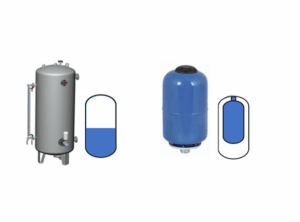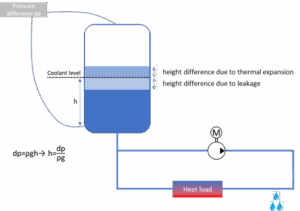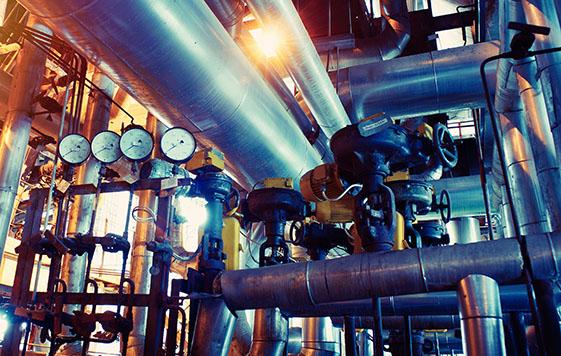Leakages are a common problem in all hydraulics systems where pressurized medium is circulated through pipelines and pipe components with multiple connection points. The possibility of a leakage is minimized by pressure testing the cooling systems and pipelines with higher pressure than the operation pressure. Even if these tests are carried out the coolant lines might start leaking as result of constant vibration, thermal expansion, and contraction. Leakage may also be so small that it is not noticeable, because pressure won’t drop during the tests. In cases of slow leakages, the coolant has time to vaporize before it leaves any mark of leakage and for this reason the leakage is almost impossible to find. Some connection points like mechanical sealings will always have some leakages and there are no fully leak-proof mechanical sealings available in the market. Mechanical sealings are used for example at pumps shafts.
Minimizing the leaks
Small amounts of leakages must be accepted, and systems need to be refilled to adjust the coolant level and cooling systems pressure. Adwatec has reduced the number of connection points to minimum by using manifolds in all C-series cooling systems. Manifolds integrate coolant lines, bends, branches, sensor connections, indicator connections and valve connections in one fixed block. Adwatec uses rubber sealed thread connections instead of glued connections to enable easy maintenance and to reduce the risk of leakage.
Leakage monitoring
In addition to prevent the leakages and to make Adwatec cooling stations as leak proof as possible Adwatec cooling stations are also equipped by default with an advanced leakage detection system. Leakages can be monitored by following the static pressure and the coolant level in an expansion tank. The expansion tank’s main role is to reduce the pressure change due to thermal expansion and to dumper the suction side pressure drop that is caused by the pressurized coolant and the contraction of the air pockets. The coolant itself is practically incompressible, but when it contains microbubbles, it becomes compressible. The expansion tank is also used as coolant and pressure buffer. In case of leakage the cooling system can maintain it’s operation longer when pressurized expansion tank is used. If the expansion tank has coolant in it the cooling system maintains its functionality. By following the pressure of the expansion tank and coolant level the leakage can be detected early on, coolant can be added, and the corrective actions can be prepared.
Adwatec standard expansion tank vs. bladder tanks
The coolant level cannot be monitored if the expansion tank has a bladder in it. Adwatec uses in all cooling stations bladderless expansion tanks to enable an effective leakage detection system. Bladderless expansion tanks have other benefits as well. When using bladderless expansion tanks Adwatec is able to capture the air bubbles from coolant flow and direct the loose air from the coolant lines to the expansion tank. (More about this “micro bubble collector” in future technical releases). When using the bladder tank, the de-airing of the cooling systems is a major issue, and the system can’t really be fully de-aired. Poorly de-aired cooling system can also lead to leakages. The air can find its’ way out from cooling system that is fully liquid leak proof. If the air accumulates and creates an air pocket to mechanical sealing or valves shaft it can dry the sealing surface making it leak the air out. If the seal dries out it can be damaged resulting to coolant leaks. If bladder tanks bladder breaks air can bleed out from the system and it can be hard to notice. In this scenario the cooling system doesn’t have a working expansion tank making the cooling system exposed to thermal expansion and cavitation.
 Advantages of using Adwatec’s expansion tank
Advantages of using Adwatec’s expansion tank
- Advanced leakage monitoring and knowledge of the coolant level
- Quick de-airing and possibility to tully de-air the cooling system
- Assurance that there is always correct amount of air in expansion tank
- No bladder, no risk of breaking it
Patented leakage detection system for most demanding circumstances
By using the bladderless expansion tank and Adwatec’s patented leakage detection system even more precise coolant level monitoring and leakage detection is possible. The coolant level can be monitored precisely with many different solutions like ultrasound sensors, pressure difference sensors and visual sensors. In the cooling systems the temperature is constantly changing and therefore also the expansion tank coolant level is changing. This happens due to a thermal expansion. If the cooling systems volume is known, it is possible to calculate the coolant volume change caused by the thermal expansion in the cooling system when the coolant temperature is also monitored. If the effect of the thermal expansion in the coolant level change is eliminated the only major reason for the coolant level change is a leakage. This way the magnitude of the leakage can be easily defined.

Focus in continuous improvement
Adwatec is constantly testing and studying its’ cooling systems to improve the performance and we have taken the fight against leakages as our mission. New applications, improvements and designs are tested, developed, and implemented constantly in our testing facilities. The leakages are prevented as far as possible and in case of pressure dropping or coolant level decreasing the cooling system is monitored precisely so the leakage can be recognized and fixed before it causes any harm.
WORDS: Veikko Verronen, R&D Engineer, Adwatec Oy
+358 40 771 9460
veikko.verronen@adwatec.com




